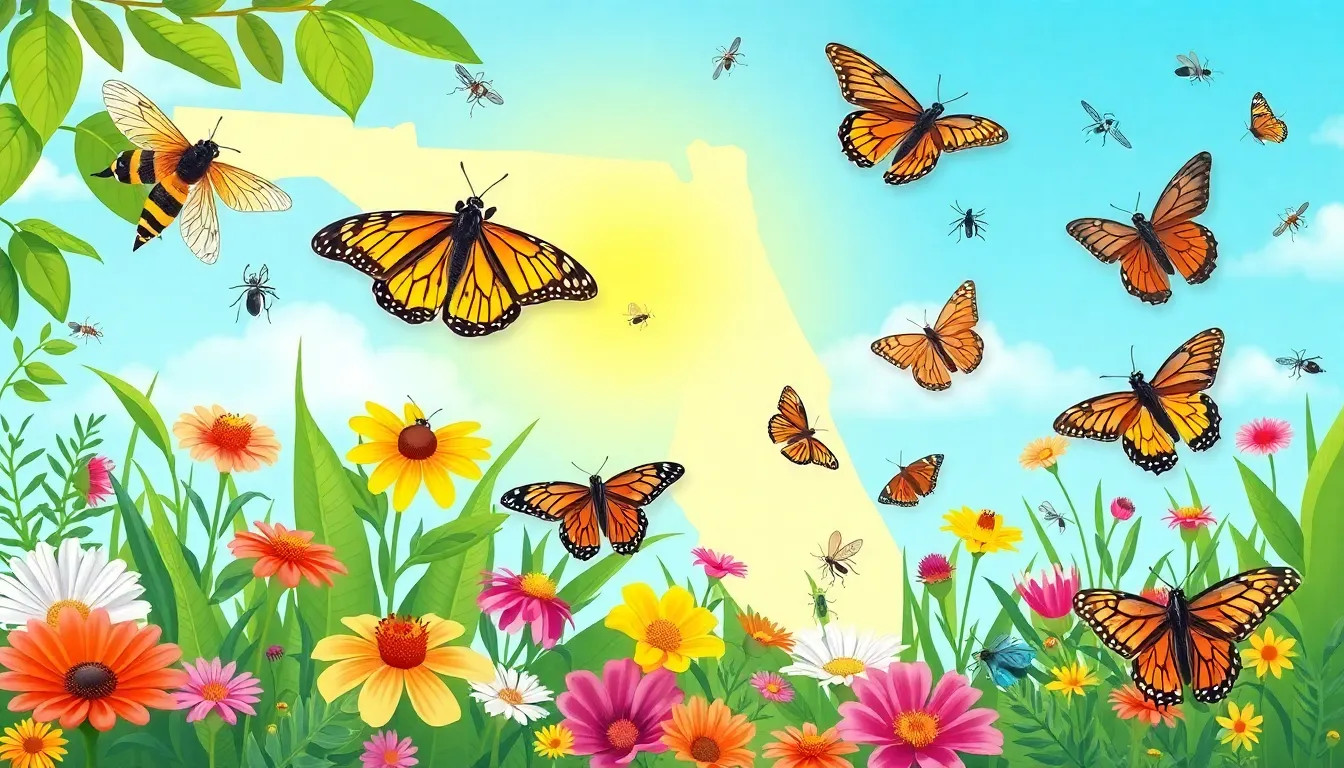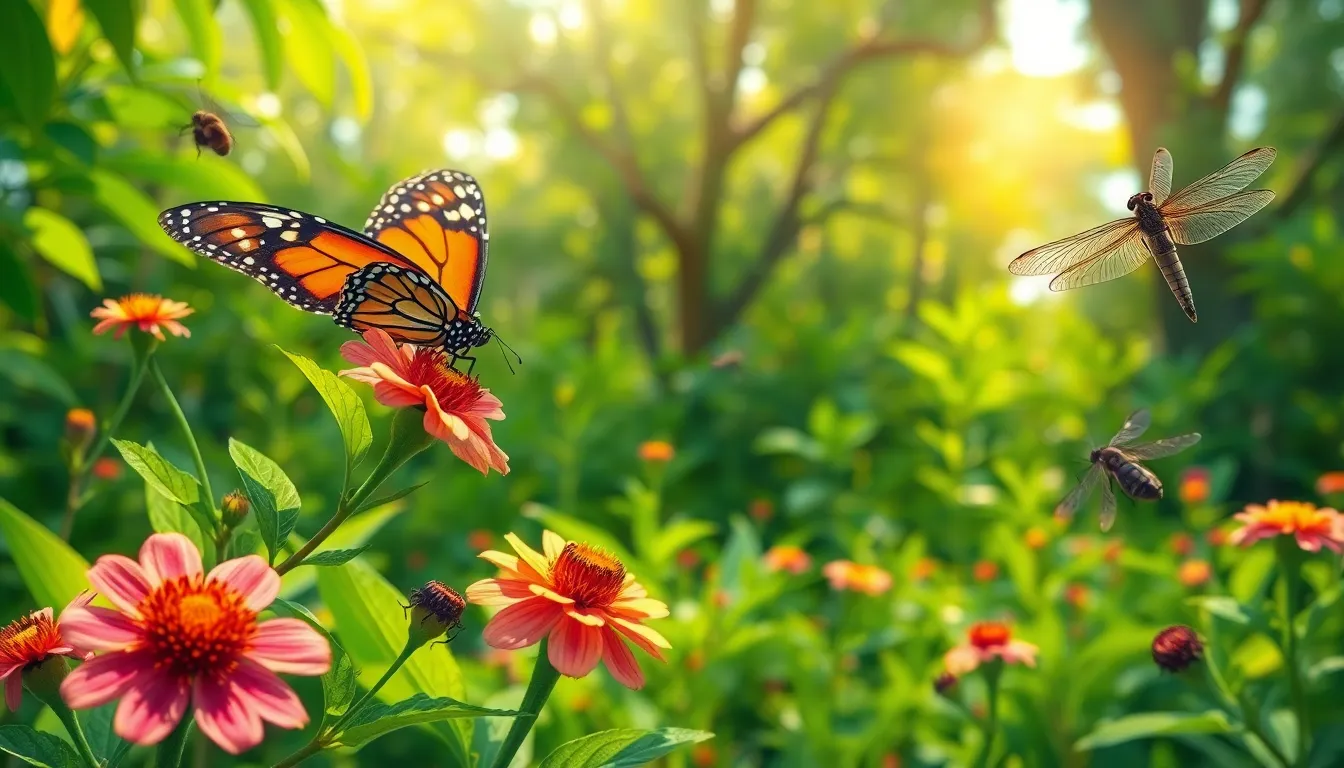Florida isn’t just known for its sunny beaches and theme parks; it’s also home to a vibrant cast of insects that could make any nature lover’s heart race. From the infamous mosquito that seems to have a personal vendetta against your picnic plans to the colorful butterflies that flutter by like they own the place, Florida’s insect scene is nothing short of a wild adventure.
Florida Insects
Florida hosts a rich array of insect species, reflecting the state’s varied ecosystems. Numerous species thrive in warm, humid environments. Mosquitoes, known for their presence, can disrupt outdoor activities and harbor diseases like Zika and West Nile virus.
Butterflies contribute beauty to the environment, with over 150 species observed in the state. The Monarch butterfly stands out for its migration patterns, journeying from North America to Central Mexico.
Beetles, another prevalent group, comprise one of the largest families among insects. They include both beneficial species, such as ladybugs that combat pests, and destructive types like the Asian longhorned beetle that threatens trees.
Ants play crucial roles in ecosystems, with species like the fire ant causing significant disruption in residential areas and also providing food sources for various wildlife.
Florida’s insect world also features insects like dragonflies and cicadas, exhibiting fascinating behaviors and adaptations. Dragonflies, with their aerial hunting skills, are vital for controlling mosquito populations. Cicadas produce loud calls, reflecting their unique life cycles and ecological importance.
These insect species not only contribute to biodiversity but also impact the local economy and ecosystems through pollination and pest control. The array of insects found in Florida exemplifies the complexities of nature, demonstrating both the challenges and beauty associated with these creatures.
Common Insects in Florida

Florida hosts a variety of insects, influencing both its ecosystems and human activities. The state’s warm climate fosters numerous species, each playing distinct roles.
Pollinators
Bees top the list of vital pollinators. Numerous species, including honeybees and native bumblebees, populate Florida. Butterflies also contribute significantly to pollination, enhancing floral diversity. Moths, although often overlooked, assist in nighttime pollination. In addition to these, hummingbird moths perform dual roles as both pollinators and food sources for birds. Together, these insects support local agriculture by increasing fruit and vegetable yields.
Pests
Mosquitoes rank among Florida’s most notorious pests, posing risks such as Zika and West Nile virus. Fire ants infest lawns and gardens, creating painful stings for those who cross their paths. Termites threaten structural integrity by damaging wooden structures. Cockroaches, common in warm climates, can spread diseases and allergens. Bed bugs, despite their small size, create significant sleepless nights for many Floridians. These pests impact both health and daily life, highlighting the constant battle between residents and troublesome insects.
Unique Insects Found in Florida
Florida boasts a remarkable array of unique insects, each contributing to the state’s rich biodiversity.
Endemic Species
Endemic species such as the Florida Keys tree snail thrive in the coastal regions. This snail, with its striking shells, creates a colorful addition to the local ecosystem. The Florida ivory-billed woodpecker serves as another example, although its existence remains a subject of debate due to limited sightings. Various other insects, like the Florida leafwing butterfly, adapt to tropical environments by exhibiting distinctive colors and behaviors tailored to their habitats. These insect species play crucial roles in local food webs and contribute significantly to pollination efforts across the state’s landscapes.
Rare Species
Several rare species inhabit Florida, drawing interest from entomologists and nature enthusiasts alike. The elusive Miami tiger beetle, known for its striking appearance, can often be found near sandy habitats. Similarly, the exceedingly rare thought-to-be-extinct butterfly species, the Palatka skipper, has reemerged, thrilling conservationists. Additionally, the endangered Florida panhandle emerald dragonfly showcases unique traits, making it a subject of ongoing study. Each of these rare insects underscores the need for conservation efforts, highlighting Florida’s delicate ecological balance and the importance of preserving its unique insect diversity.
Insect Habitats in Florida
Florida’s diverse habitats support a rich variety of insect species, each thriving in unique environmental conditions. Insects play vital roles in ecosystems, contributing to pollination and pest control.
Wetlands
Wetlands host numerous insect species due to their rich biodiversity. Mosquitoes thrive in these water-saturated areas, often causing discomfort for residents and visitors. Dragonflies patrol the skies, preying on mosquitoes and providing natural pest control. Additionally, various aquatic insects, such as mayflies and caddisflies, inhabit these ecosystems, enhancing food webs. Plant-eating insects, like certain leafhoppers, contribute to vegetation management. The intricate interactions between these species underscore the ecological significance of Florida’s wetlands.
Forests
Florida’s forests present a habitat for many insects, fostering both beneficial and harmful species. Bees and butterflies pollinate flowering plants, supporting forest regeneration. Ants build complex colonies, aerating the soil and aiding in decomposition. Some beetles, including the wood-boring types, can damage trees, affecting forest health. Cicadas add to the soundscape with their calls during summer months. These forests serve as crucial ecosystems where various insects interact and contribute to the overall balance of nature.
Importance of Florida Insects
Florida insects contribute significantly to ecosystem health and human welfare. Pollinators such as bees, butterflies, and moths enhance floral diversity, driving agricultural productivity. Local crops, including fruits and vegetables, thrive due to these vital insects, significantly benefiting farmers and the economy.
Pest control also plays a critical role in Florida’s ecosystems. Dragonflies help regulate mosquito populations, reducing disease risk to humans. Fire ants, while often bothersome, contribute to soil aeration and nutrient recycling, creating healthier environments for plant growth.
Unique species add to Florida’s ecological richness. The endemic Florida Keys tree snail represents the delicate balance of local ecosystems. The endangered Florida panhandle emerald dragonfly showcases the need for conservation efforts, as rare insects often indicate ecological health.
Various habitats in Florida support diverse insect populations. Wetlands host insects that promote natural pest control, while forests harbor beneficial pollinators and decomposers. Urban areas, despite their challenges, offer opportunities for insects to thrive, demonstrating resilience and adaptability.
Ongoing research underscores the significance of Florida’s insects in maintaining biodiversity. Understanding their roles promotes awareness and encourages conservation. Engaging the public through education can foster a sense of responsibility toward these essential species.
Highlighting the achievements of insect species leads to greater appreciation for their contributions. It is crucial to acknowledge the interdependence of insects and other wildlife in Florida, as well as the importance of preserving their habitats.
Every insect in Florida plays a distinct role in shaping the state’s vibrant ecosystems and supporting its economy. Protecting these insects allows for sustainable environments where both nature and humans can flourish.
Conclusion
Florida’s insect population is a fascinating blend of beauty and challenge. From the vibrant butterflies that grace the skies to the pesky mosquitoes that can disrupt outdoor enjoyment, these creatures play vital roles in the state’s ecosystems. Their contributions to pollination and pest control are essential for both natural habitats and agriculture.
The unique insect species found in Florida highlight the need for conservation efforts. Protecting their habitats ensures the continued health of the environment. As residents and visitors engage with this diverse insect world, they can appreciate the intricate balance of nature and the importance of safeguarding these vital species. Florida’s insects are not just part of the landscape; they are integral to the state’s ecological fabric.

